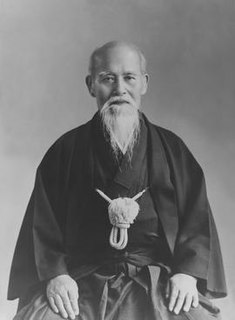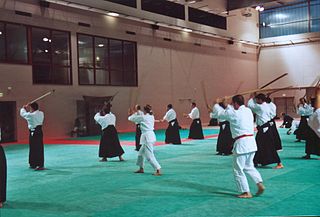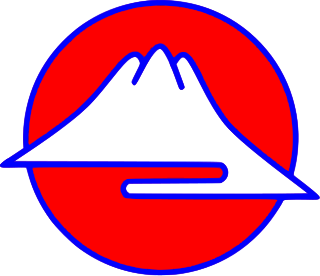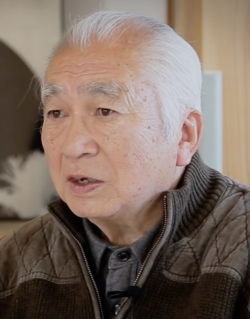
Aikido is a modern Japanese martial art that is split into many different styles, including Iwama Ryu, Iwama Shin Shin Aiki Shuren Kai, Shodokan Aikido, Yoshinkan, Aikikai and Ki Aikido. Aikido is now practiced in around 140 countries. It was originally developed by Morihei Ueshiba, as a synthesis of his martial studies, philosophy and religious beliefs. Ueshiba's goal was to create an art that practitioners could use to defend themselves while also protecting their attackers from injury. Aikido is often translated as "the way of unifying (with) life energy" or as "the way of harmonious spirit". According to the founder's philosophy, the primary goal in the practice of aikido is to overcome oneself instead of cultivating violence or aggressiveness. Morihei Ueshiba used the phrase masakatsu agatsu katsuhayabi" to refer to this principle.

Morihei Ueshiba was a Japanese martial artist and founder of the martial art of aikido. He is often referred to as "the founder" Kaiso (開祖) or Ōsensei (大先生/翁先生), "Great Teacher".

Daitō-ryū Aiki-jūjutsu, originally called Daitō-ryū Jujutsu, is a Japanese martial art that first became widely known in the early 20th century under the headmastership of Takeda Sōkaku. Takeda had extensive training in several martial arts and referred to the style he taught as "Daitō-ryū". Although the school's traditions claim to extend back centuries in Japanese history there are no known extant records regarding the ryū before Takeda. Whether Takeda is regarded as either the restorer or the founder of the art, the known history of Daitō-ryū begins with him. Takeda's best-known student was Morihei Ueshiba, the founder of Aikido.
Morihiro Saito was a teacher of the Japanese martial art of aikido, with many students around the world. Saito's practice of aikido spanned 56 years, from the age of 18, when he first met aikido founder Morihei Ueshiba, until his death in 2002.
Uchi-deshi is a Japanese term for a live-in student/apprentice who trains under and assists a sensei on a full-time basis. The system exists in kabuki, rakugo, shogi, igo, aikido, sumo, karate and other modern Japanese martial arts.
Iwama-style Aikido(岩間合気道) is the style of aikido that was taught in Iwama by the founder of aikido, Morihei Ueshiba, and especially the lineage passed on through Morihiro Saito, a close disciple who was given responsibility over Iwama dojo by Ueshiba.
The Iwama Dōjō is a dōjō built by the founder of aikido, Morihei Ueshiba, who lived there from 1942 until his death in 1969. It is located in the former town of Iwama and became an important historical location for the development of aikido and "a Mecca to the aikido community." This dojo is also where Morihiro Saito, one of the founder's closest students, learned and taught aikido from 1946 until 2002 developing what is often referred to as the Iwama Style.

Hitohiro Saito is an aikido instructor and founding headmaster of Iwama Shin-Shin Aiki Shuren-kai. Hitohiro is the son of Morihiro Saito. At age of seven, he started to learn aikido from Morihei Ueshiba, the founder of aikido, who cared for him as a grandson.. After Ueshiba died in 1969, he continued his practice with his father. The younger Saito became an official instructor of the Iwama dojo in 1986 and remained so until 2004 when he separated from the Aikikai organization and formed his own group. Since 2009 he is also identified as Hitohira (仁平) Saito.

Aiki-ken is the name given specifically to the set of Japanese sword techniques practiced according to the principles of aikido, taught first by Morihei Ueshiba, then further developed by Morihiro Saito, one of Ueshiba's most prominent students. Currently, Iwama Shin-Shin Aiki Shuren-kai is the main proponent organization.
Gozo Shioda was a Japanese master of aikido who founded the Yoshinkan style of aikido. He was one of aikido founder Morihei Ueshiba's most senior students. Shioda held the rank of 10th dan in aikido.

Takashi Kushida was a Japanese aikido master and the chief instructor of Aikido Yoshokai Association of North America. He began his study of Aikido under Gozo Shioda in 1953 and lived at the Yoshinkan Dojo as a professional student (uchideshi) for over 12 years. In 1964 he became a Shihan. He was awarded “Menkyo Kaiden” and 8th Dan in 1982 by Gozo Shioda. While at the Yoshinkan Dojo, Kushida handled many of Shioda's affairs and taught many of the Yoshinkan instructors in place today. Following this period of intense training and instruction, Kushida was made Senior Assistant Instructor at the Yoshinkan. Between 1963 and 1973 he served as Aikido teacher to the Japanese Air Force, the Tokyo Riot Control Police, and National Railway Police. He also accompanied Shiodai in demonstrations in New Zealand and Hawaii as well as teaching at various universities, private companies, and at the Yoshinkan.During his early years as an uchi-deshi, he was instrumental in developing the Yoshinkan's current pedagogical system along with Kyoichi Inoue in consultation with Gozo Shioda.
Aiki-jō is the name given specifically to the set of martial art techniques practiced with a jō, according to the principles of aikido. Jō techniques were introduced into aikido by Morihei Ueshiba, aikido's founder, and further developed by Morihiro Saito, one of Ueshiba's most prominent students.

Yoseikan Aikido is the aikido taught at the Yoseikan Dojo in Shizuoka, Japan, under the direction of Minoru Mochizuki.
Though the art of aikido is characteristically different from other Japanese martial arts, it has a variety of identifiable styles within the family of organizations descending from the teachings of Morihei Ueshiba.

The Aikido Schools of Ueshiba (ASU) is a not-for-profit Aikido organization founded by Mitsugi Saotome Shihan upon moving from Japan to the United States in 1975. It is a federation of about 110 Dojos throughout North America.

Hiroshi Isoyama is a Japanese teacher of the martial art of aikido. He began training in the Iwama Dojo at the age of 12 as a direct student of the founder of aikido, Morihei Ueshiba in June 1949. He currently holds the rank of 8th dan shihan in the Aikikai and is that organization's Technical Councillor. Isoyama was made the acting head of the Iwama dojo on behalf of Ueshiba Moriteru following the passing of Morihiro Saito. He currently remains as Executive Advisor and senior instructor of that dojo.
Munenori Kawai (1931-2010) was an 8th dan aikido practitioner and acupuncturist, who held the roles of President of the South American Aikido Federation and Vice-President of the International Aikido Federation. He was responsible for the introduction of aikido to Brazil in 1963.
Homma Gaku, born May 12, 1950, is an aikido teacher and direct student of the founder Morihei Ueshiba.

Iwama was a small town located in Nishiibaraki District, Ibaraki Prefecture, Japan.

Stanley Pranin was an American martial artist, founding publisher, and editor-in-chief of Aikido Journal. Pranin, a researcher and archivist of aikido, has written and published several books and many articles about aikido, Daito-ryu Aikijujutsu, and Morihei Ueshiba and was an influential figure in the aikido world.










